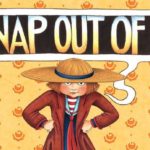?Exceedingly rare & early Ladies Side Saddle with classic raised floral carved incised tooling representative of the earliest Northern California Saddle Makers. All original including Carpet Seat, Leaping Horn, and cinches. Attributable to Main & Winchester, San Francisco. Fine condition, circa 1850s. Appraised value: $3,500.?

High Noon, a Los Angeles collectibles and appraisal company, made this appraisal for Ann Hathaway of Cloverdale, California, in 1997. Ann then donated the 150-year-old antique to the American Quarter Horse Hall of Fame & Museum and said that she did not want the saddle returned to her or sold.
Twenty-five to 30 years prior, Ann?s cousin, Wes Hanson, had given her an old sidesaddle that had come out of an estate. Ann was in her late teens or early 20s at the time, and Wes told her the story of the saddle just once. The sidesaddle had belonged to a Mrs. Williams, who had ridden the saddle on a cross-country trek from Virginia to California in 1849.
Whether or not there is any truth to Wes? tale is anybody?s guess. He was a scrounger, an antiquer (?He always had a lot of old junk around,? Ann remembers), and he was nearing 80 when he gave Ann the sidesaddle. Both Ann and James May, curator of the museum at the time, sleuthed around possible connections between Mrs. William?s West Coast destination and Williams, California, a farming city just off I-5. No one had any information to connect the saddle?s story to the town?s history.
Regardless of where the saddle came from, it is a beauty. It’s a terrific example of a western-style sidesaddle, with heavy, rugged leather feminized by delicate floral tooling. The saddle?s leaping horn catches the eye; set just under the traditional knee-hooking horn, the leaping horn holds the rider?s left leg in place when the left foot is in the stirrup.
The turquoise-carpeted seat would have been incredibly plush in its day, and a roll deepens the back of the seat. This roll could have been part of the original saddle or added later, just as the mysterious ?Good Luck?-stamped conchos might have been added to cover unsightly nail ends.
No saddlemaker?s name can be found on the saddle leathers. High Noon attributes the sidesaddle to Main and Winchester, saddlesmiths who opened a saddlery in San Francisco in 1849 and made dozens of stock, army, polo, ladies astride and side saddles. A copy of their No. 8 Illustrated Catalogue accompanied Ann?s sidesaddle appraisal; two sidesaddles similar to hers were priced at $18 and $12.
The appraisers further specify that the saddle is a ?Ladies Side Saddle,? possibly because sidesaddles were ridden by men, as well as women. In truth, the first folks to ride with both legs on the side were men.
Drawings from as long as 4,000 years ago depict men and even warriors riding sidesaddle style. Evidence of more modern men riding aside can be found as late as the 1800s. French Revolutionary War hero Layfayette rode a three-horned sidesaddle when he visited the United States in 1824.
In fact, women rode astride until the late 1300s. Around 1382, England?s King Richard II?s wife, Anne of Bohemia, rode a sidesaddle with a planchette, or platform on which to rest feet. Suddenly, riding astride was deemed unladylike and was regarded as such for the next 500 years.
Ann has ridden an English jumping sidesaddle for years and insists that it’s easier than it looks.
?It’s tricky but not hard,? Ann says. ?The trick is to have a horse with good withers and to keep your rear in the right place ? over to the right ? and to stay in the middle. It’s very comfortable and very ladylike.?
Ladylike, sure. Comfortable, maybe. Don?t you wish we could ask Mrs. Williams? opinion after her 3,000-mile ride from Virginia to California?







